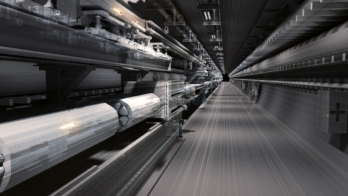Commemorating a major step in the founding of CERN.

Image credit: CERN-PHOTO-201407-133 – 87.
The convention that led to the establishment of the European Organization for Nuclear Research – CERN – was signed by 12 founding member states in Paris on 1 July 1953, under the auspices of the United Nations Educational, Scientific and Cultural Organization (UNESCO). The convention entered into force a little more than a year later, on 29 September 1954 – the official date of the laboratory’s foundation.

Image credit: CERN-HI-5307006.
CERN was created with a view to relaunching fundamental research in Europe in the aftermath of the Second World War. Sixty years on, it has become one of the world’s most successful examples of scientific collaboration. After initial discussions between scientists in the late 1940s and the first official declarations encouraging scientific co-operation in Europe at the start of the 1950s, UNESCO was to play a vital role in establishing the new laboratory. Because one of the UN organization’s mandates was “to encourage the creation of regional scientific laboratories”, it was only fitting that CERN be created under its auspices. The eminent physicist Pierre Auger, who was then director of natural sciences at UNESCO, was a driving force in the negotiations that led to the laboratory’s foundation.
Starting in 1950, UNESCO organized several major conferences, during which the creation of a large nuclear-physics laboratory was discussed. In December 1951, the first resolution to found a European Nuclear Research Council – Conseil européen pour la recherche nucléaire in French, hence the acronym CERN – was adopted. The provisional council that was set up a few weeks later drew up the convention that would establish the future laboratory. After lengthy negotiations on the details, this was approved finally on 1 July 1953.

Image credit: CERN-PHOTO-201407-140 – 2.
CERN and UNESCO have maintained close ties – a relationship that has allowed them to co-operate on many projects, mainly in the field of education. Today, the two organizations are working together on projects to establish digital libraries in Africa and to train science teachers in developing countries.

Image credit: CERN-PHOTO-201407-133 – 49.
The commemoration ceremony, held in UNESCO’s headquarters in Paris, was opened by Maciej Nalecz, director of the UNESCO Division of Science Policy and Capacity Building, the division responsible for collaboration with CERN. This was followed by speeches from Irina Bokova, director-general of UNESCO, Rolf Heuer, director-general of CERN, and Agnieszka Zalewska, the president of CERN Council.

Image credit: CERN-PHOTO-201407-133 – 58.
A round-table discussion on “Science for Peace” – the theme of CERN’s 60th anniversary – looked not only to the past, but also to how science can work to forge peace both now and in the future. One panellist – Fernando Quevedo from Guatemala, now director of the Abdus Salam International Centre for Theoretical Physics (ICTP) – was particularly honoured to be part of the celebrations because his first postdoctoral work had been at CERN at a time when the laboratory had only just opened up to postdoctoral scientists from non-member states. The closing remarks came from Frédérick Bordry, CERN’s director of accelerators and technology.

Image credit: CERN-PHOTO-201407-133 – 71.
Following the ceremony at UNESCO, a complementary event took place at the French Academy of Sciences in Paris. In 1949, the Nobel laureate Louis de Broglie, then perpetual secretary for the academy, launched the idea for a nuclear-physics laboratory on a European scale. It was therefore appropriate that the event on 1 July was opened by Catherine Bréchignac, current perpetual secretary, followed by Catherine Cesarky, who is vice-president of CERN Council.
• For a recording of the CERN–UNESCO event, visit http://cds.cern.ch/record/1713023.





